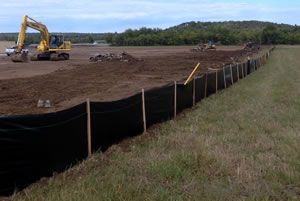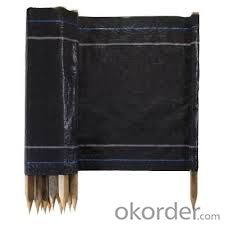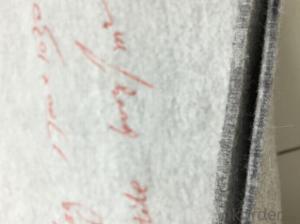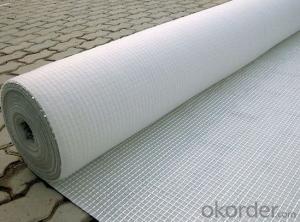Malla Geotextil Drenaje con Vallas de Lodo y Palos de Madera/Tela de Barrera de Malezas/Tela Tejida
- Loading Port:
- Qingdao
- Payment Terms:
- TT OR LC
- Min Order Qty:
- 1000 roll
- Supply Capability:
- 100000 roll/month
OKorder Service Pledge
OKorder Financial Service
You Might Also Like
Specification
1. Weed Barrier Fabric Description:
Weed Barrier Fabric, also referred to as a filter fence, is a structure composed primarily of geotechnical fabric and that is used as a form of sediment control.These temporary barriers are relatively low in cost, especially when compared to the damages they can prevent. They keep loose soils from traveling into local bodies of water and they also minimize the impact that various forms of development can have on surrounding wildlife.




2.Weed Barrier Fabric Functions and Features:
1)Excellent weed control
2)Excellent UV resistance
3)Moisture,fertilizers,air reach plants to allow for healthy soil
4)Good water and air permeability
5)Exceptional toughness and strength
6)Durable,tear-resistant,anti-rot and anti-mildew
7)Light weight,easy to install,follows natural ground contours
8)Ideal for use in landscaped beds,under decks and walkways
9)Fashionable design,high quality,competitive price
10)Long service life

3. Weed Barrier Fabric Usage:
1.Prevent leakage disposal in landfill or waste water or waste dregs disposing field.
2.River bank ,lake dam ,mine remainings ,resevoir ,tunnel ,liquid storage pool(pit ,mine)
3.Preventing leakage in subway ,basement ,tunnel ,hole .
4.Anti-salt leakage in roadbed and other ground sill.
5.The plane direction laying of dam ,the vertical direction laying for ground sill.used in the construction fence and waste material field.
6.Used in ground sill of road ,highway ,railway and waterproof layer of welling clay and wet collapsed loess.
7.Preventing leakage on rooftop.


4. FAQ:
Q1: What is your minimum order quantity?
A:The minimum order quantity is 5000 ,but it is negotiable.
Q2:What is your payment terms?
A: T/T,Western Union,Paypal,L/C...
Q3:What is your delivery time?
A:Production time usually costs 2-20 days.
Waiting to cooperate with you!
- Q: What is the high strength to strengthen the composite geotextile
- The correct product name should be high-strength reinforced composite geotextile This is a different from the traditional geotextile new products. Reinforced geotextile is made of high-strength fiber tow and non-woven composite weaving, the process is arranged in parallel fiber bundles, give full play to the role of the yarn. Non-woven mat under which the warp technology will be wrapped around the bundle, so that fiber tow and non-woven together, not only to keep the non-woven filter, but also has the strength of woven cloth. Mainly used in: rivers and lakes, drains, reservoir dam control project and power plant ash dam, mine, airport, cargo yard, railway, highway, tunnel, municipal, environmental protection and other projects, with reinforcement, isolation, Drainage, protection and other functions, is an excellent geotechnical materials; the main role is to seepage and isolation of the grassroots level, to prevent soil erosion, sand, and the embankment foundation of the embankment increased tolerance. The superiority is mainly manifested in the following aspects: high strength composite reinforced geotextile anti-aging durability, the service life can reach and more than 100 years; high strength composite geotextile puncture high strength, physical indicators far more conventional geosynthetics Material strength index; high strength composite geotextile friction coefficient, the adhesion is particularly strong, increasing the adhesion of the isolation layer, taking into account the external factors on the impact of reinforced filter layer reduced; high-strength composite geotextile reinforced acid, alkali , Salt corrosion, in the low temperature and high temperature and UV anti-aging experiments, the physical indicators stable.
- Q: Highway road crest u block below the geotextile roadway below the curb
- At present, the use of a curb stone molding machinery, prefabricated ratio can guarantee the strength of the mold release time, less water content, aggregate will segregate a large amount of water, mortar sticky mold
- Q: Under what circumstances drainage pipes need additional geotextiles
- Infiltration of water under the circumstances, geotextile play a filtering effect, Huazhi geotextile material manufacturers
- Q: How do geotextiles help with reinforcement of geogrid reinforced embankments?
- Geotextiles help with reinforcement of geogrid reinforced embankments by acting as a separation layer between the geogrid and the embankment material. They prevent the intermixing of soil particles, enhance the load distribution, and provide additional stability to the embankment. Additionally, geotextiles improve the overall performance of the geogrid by reducing the potential for clogging and maintaining its long-term design strength.
- Q: How do geotextiles help in preventing shoreline erosion?
- Geotextiles help in preventing shoreline erosion by acting as a barrier between the land and water, providing stabilization to the soil and preventing it from being washed away by waves or currents. They also help in promoting the growth of vegetation, which further reinforces the shoreline and reduces erosion.
- Q: How do geotextiles help with soil reinforcement in retaining wall applications?
- Geotextiles help with soil reinforcement in retaining wall applications by providing additional strength and stability to the soil. They are placed between the soil and the retaining wall to distribute the weight and pressure evenly, preventing excessive soil movement and potential wall failure. Geotextiles also allow water to drain freely, reducing hydrostatic pressure and preventing water accumulation behind the wall, which can weaken the soil and cause erosion. Overall, geotextiles play a crucial role in enhancing the durability and effectiveness of retaining walls by reinforcing the soil and improving drainage.
- Q: What are the advantages of using geotextiles in soil erosion prevention?
- There are several advantages to using geotextiles in soil erosion prevention. Firstly, geotextiles act as a physical barrier that helps to stabilize the soil, preventing it from being washed away by rain or other water sources. Additionally, geotextiles are permeable, allowing water to pass through while retaining the soil particles, thus reducing the impact of water flow on soil erosion. Moreover, geotextiles can be installed quickly and easily, providing an efficient and cost-effective solution for erosion control. Lastly, geotextiles are durable and resistant to degradation, ensuring long-term effectiveness in preventing soil erosion.
- Q: What are the different manufacturing methods for geotextiles?
- There are several different manufacturing methods for geotextiles, including weaving, knitting, and nonwoven processes. Weaving involves interlacing two sets of yarns, warp, and weft, to create a fabric with an ordered structure. Knitting, on the other hand, uses a series of interconnected loops to form a fabric. Nonwoven processes involve bonding fibers together through methods such as needle punching, thermal bonding, or chemical bonding. Each method has its own advantages and is used depending on the specific requirements of the geotextile application.
- Q: What is the length of the lap when the two-way geogrid is used? What is the geotextile lap length?
- It should be 20cm to 40cm it, geotextiles slightly longer point
- Q: Can geotextiles be used in shoreline restoration projects?
- Yes, geotextiles can be used in shoreline restoration projects. Geotextiles are commonly used to stabilize and protect shorelines by preventing erosion, promoting vegetation growth, and controlling sediment migration. They act as a barrier, allowing water to pass through while preventing soil and sediment loss. By using geotextiles, shoreline restoration projects can effectively enhance and preserve the natural ecosystem.
Send your message to us
Malla Geotextil Drenaje con Vallas de Lodo y Palos de Madera/Tela de Barrera de Malezas/Tela Tejida
- Loading Port:
- Qingdao
- Payment Terms:
- TT OR LC
- Min Order Qty:
- 1000 roll
- Supply Capability:
- 100000 roll/month
OKorder Service Pledge
OKorder Financial Service
Similar products
Hot products
Hot Searches
Related keywords




























